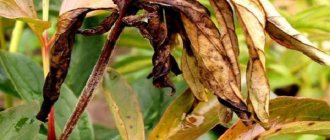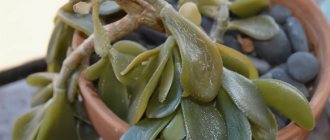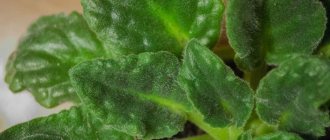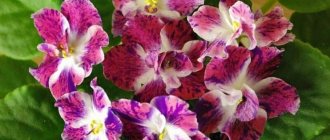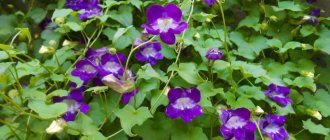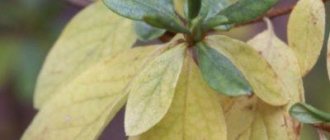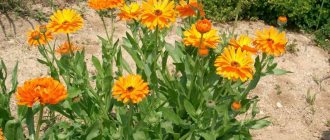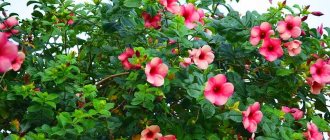Home/Flowers and Plants/Gerbera diseases with photos and their treatment, pests, prevention and control
Gerbera is a perennial flower that comes in a wide variety of colors.
Legend has it that one very beautiful nymph, Gerba, got tired of the increased attention and turned into a shy flower.
Gerbera was first discovered in the eighteenth century by the Dutch on the coast of southern Africa. They named him after the herbalist Traugott Gerber.
There are simple and double gerberas. The first look like a chamomile, the second like an aster.
Flowers love warmth and cannot overwinter in open space. It can be grown on the plot as an annual crop or grown in a pot, and taken outside in the warm season.
Garden gerberas need fertile soil, bright space, but without direct sunlight, and moderate watering.
Decorative gerberas are the offspring of Jameson's gerbera and Green-leaved gerbera.
Growing and caring for indoor gerberas
Pots with gerberas should be placed on east and west windows; on the south side they should be shaded at noon. Starting in autumn, gerberas need additional lighting.
In the warm season, the temperature should be 22-24 degrees. During flowering, approximately the same temperature should be maintained without changes.
When the plant stops blooming, gradually reduce the temperature to 12 degrees.
Reproduction of gerbera at home
Gerbera can be propagated by seeds, dividing the bush and cuttings.
Propagation by seeds
When you buy seeds, read the expiration date on the bag. The seeds remain viable for 8 months from the time of collection. It is best to sow in spring.
Step-by-step sowing instructions:
Mix equal parts of sand, peat and leaf soil, and perlite. The resulting soil should be loose and light.- Pots intended for sowing seeds must have holes for drainage; pour expanded clay into them with a layer of 3 cm.
- Next, lay the prepared substrate and compact it.
- Place the seeds on the surface of the ground and press them down a little, then sprinkle with sand.
- Place the pot in a warm room with an air temperature of 16-20°C.
- Ventilate the pot 2 times a day; the soil must be moistened all the time, so water it constantly.
- After 8-12 days you will see the first shoots. When the foliage grows, plant the seedlings into separate larger pots. There should be a distance of 8 cm between seedlings.
- When 5-6 leaves grow, the seedlings are transferred to containers with a diameter of 10 cm. First, make soil for them from 1 part of sand, humus, peat and turf soil, 2 parts of leaf soil and add a little perlite.
- When the gerberas grow up, they are transplanted into pots with a diameter of 15-20 cm.
Reproduction by dividing the bush
Choose a bush that is 3-4 years old. The plant should grow to several bushes. Separate one.
Plant it in a container, and in six months it will grow a rhizome.
Reproduction by cuttings
Choose a young plant that is not yet 3 years old.
Cut off the part of its stem that has a leaf and a node. Plant the cuttings in warm and moist soil and cover with film. Don't forget to water. Within a week, new shoots will grow. Then transplant the crop into a new pot.
If you follow the correct agricultural practices when caring for the plant, it will bloom luxuriantly and not get sick. Don't water the flower too much, but do it often.
Watering
While the flower is growing, it should be watered with soft water. Avoid getting water into the rosette of leaves.
Avoid excess moisture to prevent fungal diseases. When dormant, it is necessary to water less often, but so that the soil is not dry for a long time.
It is important that the pot stands on a tray filled with pebbles or moss. Once every 14 days it is necessary to feed the flower with special fertilizers.
Gerbera transplant
The plant is replanted once a year, in the spring, after emerging from dormancy, but before flowering begins. A newly acquired Transvaal chamomile needs to be replanted only if its roots have completely entwined the walls of the pot and begin to show through the drainage holes. In other cases, a plant grown in a greenhouse should be allowed to acclimatize to room conditions, bloom and completely absorb the entire volume of soil in the pot.
Gerberas are replanted after the roots of the plant have completely entwined the soil in the pot.
As a rule, the lifespan of a gerbera in indoor conditions does not exceed 4 years. Then it needs to be updated to obtain abundant greenery and active flowering.
Choosing a pot
When selecting a flowerpot, it should be taken into account that it should not be much wider and deeper than the previous one - only 2-3 cm.
If the difference in diameter is significant, the gerbera will have to spend a lot of effort on growing the root system, which will lead to a decrease in the number of buds and the size of the inflorescences.
The pot can be made of ceramic or plastic. A flowerpot for a well-formed bush should contain 1–1.5 liters of soil.
Preparing the soil mixture
For good development and flowering of gerbera, you need soil with a slightly acidic pH in the range of 5.5–6.0. In addition, it should be loose and easily allow air and water to pass through. A special substrate offered by flower shops is ideal for planting and replanting gerberas. But you can prepare it yourself by combining turf soil with peat and sand (or sphagnum, coconut fiber, perlite, crushed charcoal as a leavening agent) in a ratio of 2:1:1.
Compost and humus should not be added to the soil mixture; they inhibit the roots of the gerbera, slowing down the development of the flower.
Transplantation process
It is recommended to use the transshipment method, but sometimes it becomes necessary to free the plant from a substrate that has completely exhausted its nutritional properties.
In this case, the roots are cleaned of it very carefully, trying not to damage it.
How to transplant a gerbera:
- A drainage layer about 2 cm thick is poured onto the bottom of the pot. Expanded clay or crushed stone is used for this.
- Approximately a third of the free space is filled with soil mixture.
- The root system of the flower is distributed on the surface of the substrate with or without a lump of earth. Add soil, leaving about 1 cm to the top of the pot.
- Lightly press down the soil to eliminate voids. It is necessary to control the position of the root collar; it should protrude about 3 cm above the ground surface.
- Water the seedling, being careful not to get it on the leaves. Place the pot with the plant in a shaded place for several days. If it looks depressed and does not cope well with the stress it has experienced, you need to cover the bush with a plastic bag to create increased air humidity. When the plant recovers, the covering is removed.
Fertilizer application should begin no earlier than a month after planting the gerbera.
When replanting, try not to disturb the clod of earth and not injure the roots of the flower.
Reproduction
The plant propagates by dividing the bush or using seeds. In the first case, the seedling retains the characteristics of the mother plant.
If you use seeds, this may not happen. A flower that has reached 3 years old can be divided. The best time is spring.
Seeds should also be sown in spring. When 2 leaves appear, thin out. When 5 leaves appear, plant the plants in pots.
You can feed after a month. To ensure that gerberas do not rot and develop properly, it is necessary to promptly break out faded flowers.
Prevention
In order for gerberas to have high resistance to diseases and resist pathogenic organisms well, it is necessary to apply a number of preventive measures to strengthen and improve the health of the flower:
- Carefully inspect the flower before purchasing for diseases and pests.
- Steaming the substrate before planting is the best way to disinfect.
- Control the acidity of the soil and ensure the plant is properly nourished.
- Maintain proper temperature conditions, do not overheat or overcool the gerbera, otherwise its leaves will begin to curl and fall off.
- Organize proper and sufficient lighting.
- Water regularly, but carefully regulate irrigation so that excess moisture does not form, due to which pathogenic microflora can develop.
We recommend that you read our other articles that will help you avoid mistakes when growing gerberas at home:
- How does a plant reproduce?
- When and how to replant a flower after purchase and not only?
- When and how long do gerberas bloom and why don’t they?
- How to grow gerbera from seeds at home?
Diseases and pests of gerbera
- Powdery mildew appears due to frequent watering, high air humidity, and poor ventilation.
The first signs are that the leaves turn yellow and become covered with spots. If spots appear on damaged leaves, remove them. Spray healthy leaves with Fitosporin-M solution.
- Scale insects, aphids, mites, and whiteflies also cause great harm. Therefore, it is necessary to disinfect the soil, remove damaged leaves in a timely manner, and properly care for the flower.
Gerberas are harmed by cold water, sudden changes in temperature, and abuse of nitrogen fertilizers.
Nicotine sulfate, anabasine sulfate, and so on get rid of aphids. A soap solution or insecticide helps against spider mites. Whiteflies are killed by drugs containing permethrin.
Lighting requirements
The most optimal period of daylight is 12 hours. Therefore, it is better to choose a place where sufficient bright sunlight penetrates. In another case, it is allowed to be scattered. The duration and quality of flowering depends on how to care for indoor gerberas. For example, during the summer it is necessary to take the flowerpot out onto the balcony. If this cannot be done, then the room should be ventilated regularly. Streams of fresh warm air improve the process of transporting nutrients to the leaves and flowers.
From mid-summer until the end of August, this amazing chamomile “throws” all its energy into growing greenery. Since there is more than 12 hours of daylight, the buds simply do not have time to set. By the end of August, a stormy period of its flowering begins, which lasts until November.
Growing problems
If the plant does not have enough light, the leaves stretch out and become less bright. If there is too much light, then such symptoms also appear.
The cause of wilting, drying and yellowing of the flower should be sought in frequent or too infrequent watering, as well as in the disease fusarium.
AllaAuthor of the article
Did you like the article?
Share with your friends:
Mosaic
Mosaic is one of the diseases of indoor gerberas and those growing in open ground.
The disease is caused by a virus. It is characterized by signs expressed in the formation of sharply limited spots on the leaves. Their shape is different. Color yellow-green.
As the disease progresses, the leaf blade becomes deformed. In some situations, pigmentation appears along the veins.
Sometimes necrosis occurs. Sources of the virus include plants of the pumpkin family. They have a perennial or biennial character.
Insects spread the virus. They have a piercing type of mouthparts. For example, this is aphids.
The virus is transferred mechanically. There is no need to change the soil of the plant, since the virus does not settle there. Disease activity occurs at the end of the growing season.
The reason is a decrease in sunlight, an increase in humidity or a decrease in temperature. To combat mosaic, it is necessary to place Gerberas away from pumpkin plants. Preventive measures need to be taken.
Kinds
Gerbera Jamesonii / Gerbera jamesonii
This species is the ancestor of all varieties grown indoors. This herbaceous plant, which grows for many years, has a thick stem. The leaves are collected in a rosette and located just above the ground; the leaves are large, grow up to 20 cm, pinnate, sometimes pubescent; axillary buds are sometimes found at the base of the leaves. The inflorescence is similar to a chamomile flower, a basket - up to 10 cm in diameter - appears on the edge of the peduncle and is often considered by inexperienced gardeners to be one flower, although in reality these “petals” are nothing more than independent reed flowers of different colors - yellow, red, white and etc. – only about 30 shades. They are located in one, two or three rows; There are both wide and narrow. The "core" consists of tubular flowers and comes in a variety of colors.
- Recommendations for growing cineraria in a flower bed
Signs of improper care and microclimate
Improper care of home gerberas leads to comprehensive inhibition of the growing season. In addition, a weakened plant is often attacked by pathogenic fungi and flower pests. Lack of timely correction leads to irretrievable death of the specimen. Most often, the plant suffers due to damage to the root system or improper lighting.
Symptoms of improper care include:
- Uneven leaf color.
- Yellowness of two or more leaves.
- Lodging of flowers and buds.
- Wilting of leaf blades.
How to determine damage to the root system
The turgor of gerbera leaves does not always depend on soil moisture. Quite often, limp leaves are observed in plants with a damp substrate in a flowerpot. Novice gardeners make the mistake of increasing the intensity of watering when they see limp greens. First you need to make sure that the substrate is really dry.
The lack of elasticity of the leaves against the background of wet soil indicates problems with the root system. The plant simply does not have access to moisture.
The reason for this twofold situation is:
- infection of the root system with rot;
- inappropriate soil acidity;
- pot too big;
- contaminated soil.
Moisture in the soil should be distributed as follows:
- a small part comes out through the drainage holes;
- the proportion of evaporation depends on the ambient temperature, but it is rarely high;
- the bulk of the water should be consumed by the root system.
The fibrous root of the gerbera slowly develops the soil. The roots are located at the depth of the first third of the flowerpot. Moisture from the deeper layer remains unclaimed and serves as fertile ground for harmful fungi. In addition, the root system does not grow in width, which must be taken into account when choosing a flowerpot.
It is recommended to occasionally moisten the substrate with a slightly pink solution of potassium permanganate (potassium permanganate) to prevent root rot.
You should also carefully consider the choice of flowerpot and the composition of the substrate. Too large a flowerpot leads to acidification of the soil and inhibition of vegetation. Gerbera reacts extremely negatively to an excess of peat.
Incorrect planting of a specimen requires emergency intervention:
- The plant is moved to a smaller pot.
- Add dry soil to reduce moisture.
- Reduce the intensity of watering and fertilizing.
Be sure to inspect the roots for rot. If necessary, treat with one of the fungicides.
How to determine lighting violations
Indoor gerbera is a light-loving plant that cannot tolerate intense sunlight. Signs of lighting violations and corrective measures:
Lack of natural light leads to lengthening of leaves and stretching of petioles. The effect of “one-sided” vegetation is observed. Leaves grow more actively on the side of the window. The opposite side of the rosette slows down growth and turns yellow. You need to place the flowerpot closer to the light or organize artificial lighting with a phyto-lamp. The tropical beauty requires 12 hours of daylight.
Excess sunlight leads to general oppression of the plant. The leaf rosette becomes discolored, losing its green pigment. It is best to put the pot away from bright light or shade it.
How to identify signs of gerbera disease
Disease damage to a plant can be either primary or secondary. That is, the flower entered the house already infected, its immunity was not enough and the pathogenic flora developed. Or improper care has led to insufficient nutrition, decreased immunity and damage by harmful fungi and bacteria.
The primary signs of diseases are very similar to the reaction to stress and improper care:
- the plant's vegetation stops abruptly;
- decorative features are lost;
- changes in leaf color appear.
Sometimes pest damage is added to gerbera disease. Timely treatment with appropriate products will help avoid the loss of a tropical flower.
Late blight and sclerotinia
Fungi can cause sclerotinia in plants. The disease has symptoms:
- rapid withering process;
- formation of depressed spots;
- a white or gray coating appears on the spots;
- The pathogen persists in the soil.
Spots appear at the base of the leaf and on the peduncle. The disease develops in waterlogged soil. The reason is the excess of organic fertilizers and increased room temperature.
To combat the disease, substrates that are easily aerated are used. The correct watering regime and the existence of a ventilation system influence the development of the plant. If signs of disease appear, stop watering the flower. The wet soil is replaced with partially dry soil and treated with fungicides.
The cause of late blight in plants is said to be fungi. There are several signs of the disease. The first thing that appears is drying of the leaves. The sheet begins to dry from the outside.
Whitefly
The pest is presented in the form of a small moth. The wings are dull white. The body is elongated, somewhat reminiscent of an aphid.
Parasites leave larvae on the lower parts of the leaves. Reproduction is fast and active. The following methods can be used for detection:
- inspect the reverse side of the sheet;
- the plant is shaken;
- the sheets are palpated.
If there is a pest on the flower, when shaken, they fly apart. When palpated, you can feel a sticky substance on the Gerbera - this indicates a whitefly infection.
Getting rid of harmful insects occurs by washing the sheets. The temperature in the room decreases. This option does not guarantee that it will be possible to completely get rid of pests. Intexicides are used for treatment.
How to properly recognize your stress response
The rules for caring for and growing garden and indoor crops have significant differences. In order to understand exactly why the leaves of an indoor gerbera turn yellow, it is necessary to check the condition of the plant itself and the conditions of its maintenance. Don’t panic if one leaf of a recently purchased plant turns yellow.
You should remember the adaptation period, which lasts from one to two weeks. At this time, the gerbera is in a state of stress and gets used to the new microclimate.
Indoor gerbera responds by yellowing leaves to stress caused by:
- change of place;
- transplantation
You should give the flower time to get used to the new lighting, different temperature and air humidity.
The best option would be not to disturb it unnecessarily, not to rearrange or rotate the flowerpot. Watering should be done moderately, without enthusiasm.
At first, the reaction to stress and incorrect agricultural practices are very similar. The difference is that the plant can adapt to stress.
Sure signs of successful adaptation are:
- pronounced leaf turgor;
- active growth of new leaves;
- stopping the spread of yellowness.
This will not happen if the plant suffers due to improper care.
Botanical description
The birthplace of the gerbera flower (lat. Gerbera) is the subtropical and tropical zones of Africa; the genus itself is part of the Asteraceae family and has approximately 70 species. The gerbera flower is a herbaceous plant that grows for more than one year. The peduncle of this plant has no leaves and grows up to 60 cm in height. Gerbera leaves are collected in a rosette at the root, long - up to 35 cm. Flower baskets come in different shades, large flowers grow one at a time and reach a diameter of 15 cm; Some varieties have semi-double flowers. There is usually only one gerbera grown indoors - Jameson's gerbera (Gerbera jamesonii).
